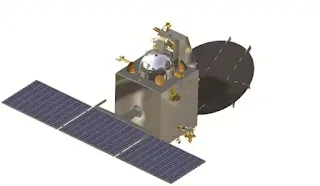ISRO confirms Mangalyaan mission over, Mars Orbiter craft non-recoverable
ISRO on 3 October confirmed that the Mars Orbiter (MANGALYAAN) craft has lost communication
 |
| Mangalyaan |
The Indian Space Research Organisation on 3 October confirmed that the Mars Orbiter craft has lost communication with ground station, it's non-recoverable and with this the Mangalyaan mission has attained end-of-life.
Giving an update on the Mars
Despite being designed for a life-span of six months as a technology demonstrator, the MOM lived for about eight years in the Martian orbit with a gamut of significant scientific results on Mars as well as on the Solar corona.
Though it has lost communication with the ground station, due to a long eclipse in April 2022, ISRO said. ISRO deliberated that the propellant must have been exhausted, and therefore, the "desired altitude pointing" could not be achieved for sustained power generation.
"It was declared that the spacecraft is non-recoverable, and attained its end-of-life", an ISRO statement said, adding, "The mission will be ever-regarded as a remarkable technological and scientific feat in the history of planetary exploration."
Launched on November 5, 2013, MOM completed 300 days of interplanetary journey and was inserted to the Martian orbit on September 24, 2014.
"Equipped with a five scientific payloads onboard, during these eight years, the mission has gifted significant scientific understanding on the Martian surface features, morphology, as well as the Martian atmosphere and exosphere," ISRO said.
Explained: How Back-to-Back Eclipses Could Have Caused ISRO’s Mangalyaan to Run Out of Fuel and Battery
 |
| Mangalyaan |
But now, recent reports have indicated that Mangalyaan has finally run out of fuel and battery power. And apparently, back-to-back eclipses — including one that lasted seven-and-a-half hours — are responsible for the probe losing power.
The ‘eclipses’ referred to in these reports are essentially phases in which the satellite did not receive any sunlight to recharge itself through the solar cells which, in turn, reduced its power to transmit and receive signals from the Earth station. However, the reports are yet to specify whether these eclipses were caused by any of the Martian moons, or Mars itself.
Since Mangalyaan’s satellite battery had been designed to handle an eclipse duration of only one hour and forty minutes, the prolonged eclipse likely took a toll on the orbiter, resulting in its battery getting drained beyond the safe limit.
Sources claim that ground control has lost communications with the spacecraft, fuelling speculations about the end of its life.
The satellite has gone into eclipse earlier and performed automatic manoeuvres independently to come out of eclipse and re-establish communications. But in this scenario, since there is no fuel left, it would not be able to perform those automated movements. However, there is also the slim chance that the antenna is pointing elsewhere while changing its direction to re-establish communication with Earth after the eclipse, as per pre-installed software.
The Indian Space Research Organisation (ISRO) is still trying to figure out whether Mangalyaan has really run out of power or if this is merely a communication problem caused by the change of direction of the antenna. But multiple sources have said it would not be possible to recover the orbiter and re-establish communication with the Mars probe.
ISRO is yet to issue any official statement regarding the matter. In the meantime, the Indian space agency continues on work on various missions that are currently in its pipeline, including the Mangalyaan-2.


Comments